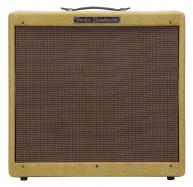An Exceptional 1957 Fender Tweed Bandmaster
1957 Fender Bandmaster (Narrow Panel)
This is an exceptional 26 watt tweed "narrow-panel" cabinet tube combo legend that weighs 40 lbs. The solid pine cabinet measures 21.25 inches wide x 22.50 inches high x 10.50 inches deep. Three original ten-inch Jensen P10R "Special Design" Speakers with stamped codes: "220-811" and "220947" (Jensen 11th week of 1958 and 47th week of 1959), all with "P10R C 5636 6". Top control panel with two instrument inputs, two microphone inputs, one volume control, one presence control, and two tone controls. Cabinet expertly recovered to style over twenty years ago in period tweed with period brown tweed-era grill cloth. The serial number "S01706" (ca. November 1957) is written in blue ink on the tube chart, which also has the letters "GI" stamped in black (September 1957). The tweed covering is almost mint. The original leather handle has been replaced with an identical later one. A wonderful sixty-seven-year old legend… Pete Townshend used a 1959 3 x 10 Bandmaster for the recording of "Who's Next"
History: We originally purchased this wonderful amplifier in 2006 and kept it for demo purposes. In October 2013 we had the amp fully serviced with all caps and tubes replaced to '57 specification by 'Tone-Wizard' Doug Anderson of Tone Zone in Altadena at a cost of $2,200. In May of 2019 we had Doug Anderson do a routine check at no charge.
We recently spoke to the person that we purchased this amp from in 2006 and he confirmed that the replacement speakers - dated June 1958 & December 1959 had been sourced and replaced at the time of the re-covering.
"Although there was no Bandmaster in the Down Beat insert of July '55, implying a temporary halt in production, a new narrow-panel version with three 10" Jensens (model 5E7) replaced the old model for the '55-56 full-line catalog. Conservatively rated at 26 watts, this is the amp most players think of today as a tweed Bandmaster. A Presence control and a Ground Switch were new additions to the control panel. A new logo plate with "Fender Bandmaster" in script set off the front of the restyled cabinet (21¼"x22½"x10½"), as did the new acoustically transparent grille cloth. The preamp section included a 12AY7 (one half for the two Bright inputs, the other half for the two Normal) and three stages of 12AX7 preamp common to all four inputs, including a direct-coupled cathode follower just before the tone circuit. Other new designs included the employment of negative feedback in two sections, a fixed bias supply for the two 6L6G power tubes, and the use of only one half of a 12AX7 for the new phase splitter (split-load inverter). A 5U4G rectifier was still standard, but the DC filter section now included a choke to supplement the filter caps. The '55 Bandmaster was considerably more advanced electronically than the versions released just two years prior. Two 5881 power tubes replaced the 6L6s c. '57; otherwise, little was changed until 1960. Models from '59 still used the 5E7 circuit. The last of these were fitted with the new brown plastic handle." (Teagle & Sprung. Fender Amps. The First Fifty Years. pp. 90/91).






